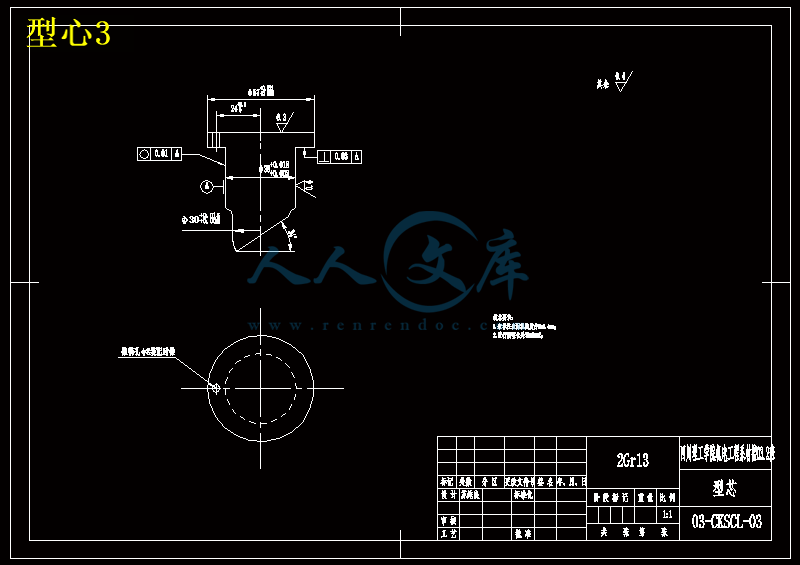摘 要
注射成型加工质量的优劣是塑料加工业技术发展水平的标志之一,同时反映了模具设计和制造的水平。详细介绍了刷座注塑模具设计的整个过程。首先通过对塑件的结构和成型工艺分析,确定塑件的分型面与浇口结构;然后再进行模具零件设计,如成型零件、脱模机构等等。同时在整个设计过程中,还要通过计算机辅助工具CAD/CAE进行设计。重点阐述如何利用CAE软件,将注射成型中塑料熔体在型腔内充填模拟,通过对模拟结果的分析与评判,有效预防了原模具设计方案用于实际生产时可能出现的问题,以生产出合格的产品。而在结构设计方面,重点阐述了齿轮齿条抽芯机构设计要点,模具结构紧凑、合理。
关键词: 注塑成型、注塑模设计、工艺分析
ABSTRCT
Injection molding procesing quality is the one of symbols of the quality that plastic procesing industry and technogical devlepment.also deflected the mold design and manufacturing level.Details on the entire procesing of the Brush Block Injection Mold Design.At the first,the structure of the parting line and sprue was determined based on the analysis of the structure and forming technology of the plastic.Then design for the mold parts,such as molding parts,demoulding mechanism,and so on.At the same time throughout the design process, through the computer aided design CAD and CAE tools.Details on how to use CAE tool.For simulating the filling process of plastic melts in the cavity of injection moulds. The analysis on the analog result can help effectively modify the design scheme and prevent the problems that may occur in the production And in the design of structure,The key points in designing the side core-pulling mechanism with gears and rack were stated in detail. The mould is compact in structure and effective in operation.
Keywords: Injection Molding,Design of injection mould,Technique analysis.
目 录
第一章 概述……………………………………………………………………………1.
1.1国际、国内塑料模具成型发展概况……………………………………………1
1.2塑料模具设计方法主要发展方向………………………………………………3
1.3毕业设计课题资料查询…………………………………………………………3
1.4毕业设计思想简述………………………………………………………………7
第二章 塑料制件的工艺性分析及工艺结构设计………………………………………8
2.1成型塑料制件结构工艺性分析…………………………………………………8
2.2塑件三维CAD建模及CAE分析…………………………………………………9
2.3根据CAE分析结论进行模具工艺设计…………………………………………14
第三章 选择注射机及注射机工艺参数校核……………………………27
3.1注塑机的技术规范………………………………………………………………27
3.2注塑压力的核核(可计算、可应用CAE分析结论)…………………………28
3.3锁模力的校核……………………………………………………………………29
第四章 模具设计…………………………………………………………………30
4.1确定标准注塑模架………………………………………………………………30
4.2模具成型零件设计………………………………………………………………30
4.3型腔成型尺寸计算………………………………………………………………31
4.4型腔壁厚计算和强度校核………………………………………………………34
4.4脱模机构设计……………………………………………………………………34
4.5模具主要连接、定位、导向件设计……………………………………………37
4.6模具冷却系统设计………………………………………………………………40
第五章 绘制模具图………………………………………………………………41
5.1绘制总装结构图…………………………………………………………………43
5.2绘制重要零件图…………………………………………………………………43
5.3校对、审图………………………………………………………………………43
5.4模具设计的标准化问题…………………………………………………………44
第六章 结论…………………………………………………………………………….45
参考文献 …………………………………………………………………………………46
致谢 ………………………………………………………………………………………47
附件A………………………………………………………………………………………48
附件B………………………………………………………………………………………49
第一章 概述
1.1国际、国内塑料模具成型发展概况
模具在我国古代历史上就有了记载,可以说发展的历史非常悠久,但是如今,我国的模具技术却滞后国外尤其是发达国家几十年了。继美国之后,日本成为世界上第二大模具供应国和世界上最大的模具出口国。如果在国际上分析模具统计数据,可以看到根据数据的来源不同,相应的定义与分类均有所不同。1996年的一项国与国之间模具贸易的研究显示了,美国以29.86亿美元的贸易额排名第一,日本以21.25亿美元排名第2位,德国以13.2亿美元排名第3位。根据ISTMA日本分部的报告(1998.5),日本模具贸易额在1996年达到4401.4亿日元,1997年达到5447.44亿日元。
近年来,中国塑料工业年均增长速度达到10%以上,塑料制品年产量位居世界第二。塑料制品在农业、塑料包装、塑料管材和异型材、汽车、家电、电子、交通等领域发展迅猛,掀起了一股投资热潮。
行业分析 塑料模具在高技术驱动和支柱产业应用需求的推动下,形成了一个巨大的产业链条,从上游的材料工业和加工、检测设备到下游的机械、汽车、摩托车、家电、电子通信、建筑建材等几大应用产业,塑料模具发展方兴未艾。







 川公网安备: 51019002004831号
川公网安备: 51019002004831号